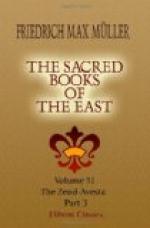the defects of tradition by their aid. Burnouf,
laying aside tradition as found in Anquetil’s
translation, consulted it as found in a much older
and purer form, in a Sanscrit translation of the Yasna
made in the fifteenth century by the Parsi Neriosengh
in accordance with the old Pahlavi version. The
information given by Neriosengh he tested, and either
confirmed or corrected, by a comparison of parallel
passages and by the help of comparative grammar, which
had just been founded by Bopp, and applied by him
successfully to the explanation of Zend forms.
Thus he succeeded in tracing the general outlines
of the Zend lexicon and in fixing its grammatical
forms, and founded the only correct method of interpreting
the “Avesta.” He also gave the first
notions of a comparative mythology of the “Avesta”
and the “Veda,” by showing the identity
of the “Vedic Yama” with the “Avesta
Yima,” and of Traitana with Thraetaona and Feridun.
Thus he made his “Commentaire sur le Yasna”
a marvellous and unparalleled model of critical insight
and steady good sense, equally opposed to the narrowness
of mind which clings to matters of fact without rising
to their cause and connecting them with the series
of associated phenomena, and to the wild and uncontrolled
spirit of comparison, which, by comparing everything,
confounds everything. Never sacrificing either
tradition to comparison or comparison to tradition
he knew how to pass from the one to the other, and
was so enabled both to discover facts and to explain
them.
At the same time the ancient Persian inscriptions
at Persepolis and Behistun were deciphered by Burnouf
in Paris, by Lassen in Bonn, and by Sir Henry Rawlinson
in Persia. Thus was revealed the existence, at
the time of the first Achaemenian kings, of a language
closely connected with that of the “Avesta,”
and the last doubts as to the authenticity of the
Zend books were at length removed. It would have
required more than an ordinary amount of scepticism
to look still upon the Zend as an artificial language,
of foreign importation, without root in the land where
it was written, and in the conscience of the people
for whom it was written, at the moment when a twin
language, bearing a striking likeness to it in nearly
every feature, was suddenly making itself heard from
the mouth of Darius, and speaking from the very tomb
of the first Achaemenian king. That unexpected
voice silenced all controversies, and the last echoes
of the loud discussion which had been opened in 1771
died away unheeded.
[Footnote 9: A century ago, it is said, they
still numbered nearly 100,000 souls; but there now
remain no more than 8,000 or 9,000, scattered in Yazd
and the surrounding villages. Houtum-Schindler
gave 8,499 in 1879; of that number there were 6,483
in Yazd, 1,756 in Kirman, 150 in Teheran.]
SELECTIONS FROM THE ZEND-AVESTA
THE CREATION[10]
Ahura Mazda spake unto Spitama Zarathustra, saying:—




